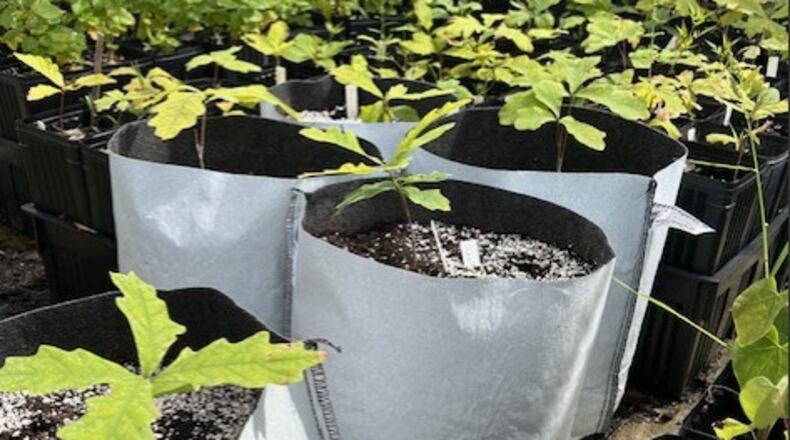Trees clean the air and help heal the environment, but things like climate change, disease and expanding development are thinning Ohio’s tree population.
MetroParks’ commitment to saving native trees starts at Cox Arboretum, where the Barbara Cox Center for Sustainable Horticulture houses a tree nursery specializing in native species. The nursery not only serves MetroParks, it has also supplied trees to the community during disasters like the 2019 tornadoes.
“Every tree that’s planted at Cox has a record, so we know when it was planted and where we got it,” says Jennifer Davit, a horticulturist at Cox Arboretum. “We have a database of all the trees. We document how well they’re doing, we inventory them, we keep track of them. That’s what makes Cox different from other Metroparks: We are an arboretum. It makes us unique.”
The tree nursery
Cox Arboretum’s tree nursery started in the wake of the Emerald Ash Borer invasion, when tens of thousands of ash trees across Ohio died.
“The Emerald Ash Borer came through and wiped out all those ash trees, and we wanted a way to replace them,” Davit says. “The goal was to produce native trees that could be planted out and would be disease-resistant and insect-resistant.”
The tree nursery focuses on growing native trees, including species that aren’t available anywhere else.
“A lot of the species that we grow you wouldn’t be able to find other places, even in local nurseries,” Davit says. “They might be really slow growing, or they might just not be marketable. But in our parks, where we have such big spaces, we can grow a lot of different trees.”
Davit says the nursery currently has about 20 native species of trees and shrubs. Park managers throughout the system request trees for their projects. Spring Run, a new conservation area, is planting a large number of trees, and Carriage Hill requested 75 trees this season.
Science and experimentation
It can take more than four years for a tree to reach a plantable size, and park staff experiment with different materials to find the best, most environmentally efficient way of ensuring trees will thrive once planted.
Currently, the team is experimenting with a new kind of planting bag as well as a new soil.
“We’re always looking for new things,” Davit said. The new soil contains living fungi to help the roots develop and to replace the need for fertilizer. “We’re always looking for ways to improve the growing process.”
Fall outlook
This year’s dry summer is causing trees to lose their leaves early, which means 2024 is not likely to be the best year for fall color.
“This year and the last few years, we’ve had so much drought that the fall color is not as good,” Davit says. “Even for established natives, the drought is stressful.”
But that doesn’t mean you can’t find beautiful leaves throughout MetroParks. Each park has something to offer. For instance:
- Cox Arboretum MetroPark, with its diversity of trees including maples and sweet gums, provides a wide range of color. Climb up the tree tower for an incredible view.
- The high, elevated views at Germantown and Twin Creek metroparks offer broad vistas of fall trees for hikers.
- Wegerzyn Gardens MetroPark is beautiful in the fall, particularly its beech trees.
- At Eastwood MetroPark, you can paddle to Riverscape and view trees along the way.
MetroParks’ special trees
Each MetroPark has amazing trees, but some stand out. Here are a few:
- Ashzilla at Island MetroPark: One of the biggest trees in MetroParks is Ashzilla, a white ash tree.
- Bea’s Tree at Englewood MetroPark: This large cottonwood tree is one of the top five largest trees in MetroParks.
- Beech Woods at Sugarcreek MetroPark: Several beech trees remain from the native forest and are more than 200 years old.
- Big Blue at Englewood MetroPark: A champion blue ash, Big Blue is one of the oldest trees in MetroParks.
- Giant pedestal oak at Wegerzyn Gardens MetroPark: This large oak survived the 2019 tornadoes. It appears to sit on a large base, hence the name “pedestal oak.”
- Ralph’s Oak in Dull Woods Conservation Area, off Wolf Creek Trail: Ralph’s Oak is a Shumard oak tree and is the fourth largest tree in the MetroParks system. It’s named for Ralph Dull, an area farmer and conservationist who leased the woods to MetroParks in 2003.
- Three Sisters at Sugarcreek MetroPark: These ancient white oak trees are more than 500 years old. The largest of the three, called the Big Sister, is more than 140 feet tall with a crown spread of 93 feet.
Jana Collier is a member of the Five Rivers MetroParks Foundation Board. To learn about the foundation and how you can help, go to metroparks.org/about/foundations.
HOW TO VOLUNTEER
Much of the seed collection and tree planting is done with help from volunteer groups. If your business or organization is interested in working with MetroParks, go to metroparks.org/volunteer or email volunteer.services@metroparks.org.
About the Author



